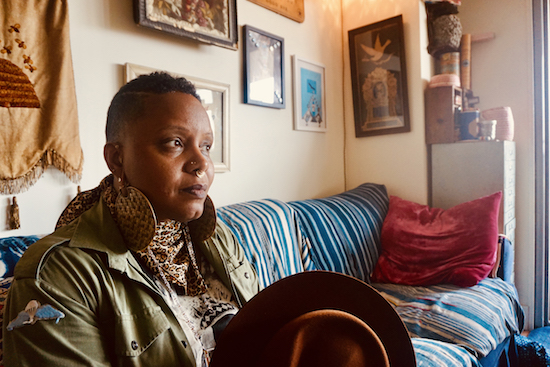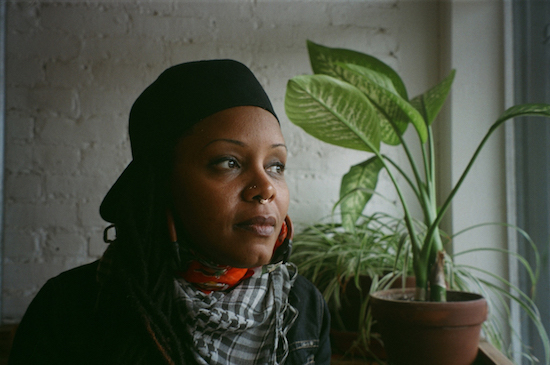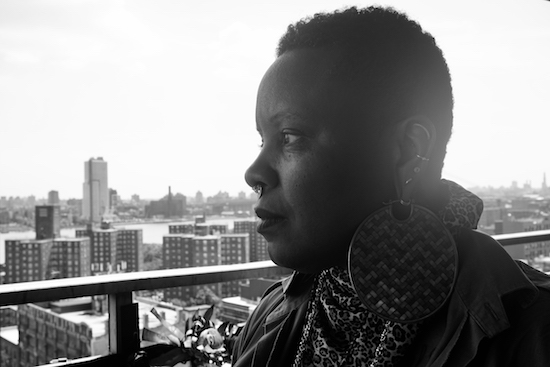Portrait by M. Tarantelli
“There’s something really interesting to me about what being in nature can do for you”, says Matana Roberts, reflecting on the role of the natural world in shaping her creative practice. For the Chicago-born sax player and multi-media artist, reconnecting with nature has become a vital route to emotional equilibrium and a key component of her creativity. “People talk about forest bathing now. It’s this idea of immersion. It brings a certain kind of balance and peace.”
Best known for her COIN COIN project – a wildly ambitious 12-album series, released through Montreal-based Constellation Records – Roberts disassembles US jazz traditions in order to transform them into a profound and visionary storytelling medium. Through her sax playing, field recordings, spoken word and singing, she explores aspects of American history, ancestry and race, with a focus on oral history, family narratives and mythology. A frequent traveller, much of her work has drawn on journeys she has made through the US South, particularly in the states of Louisiana, Mississippi and Tennessee, while voyages to parts of Asia and Africa over the past two years have also begun filtering into her work.
Recently commissioned as part of the London Borough of Waltham Forest’s People’s Forest– an arts programme exploring the history and culture of Epping Forest – she’s in the process of putting together “a mixed media installation piece” which will be performed in St Mary’s Church in Walthamstow. Though she now splits her time between the US and Europe, Roberts was stateside when I up caught with her over the phone. Like her music, our conversation was deeply enriching and illuminating, covering everything from free diving in Indonesia and visiting slave castles in Ghana to living on boats in Brooklyn.
Given that I have called her to talk about forests, I’m surprised to find that we actually spend a considerable chunk of our conversation talking about the sea. “I’m really into cold water, ice swimming and things like that”, she tells me. “I started surfing in New York City, in a place called Far Rockaway. I got so into it that I started surfing even when it was cold and I realised that I really like being in cold water. In London, sometimes I go to the Hampstead Heath Ladies’ Pond in winter, for the fact that it’s cold.”
This fascination with water partly came about due to having spent several years living on houseboats in Brooklyn, (in an area that had, incidentally, once between notorious as a spot for the mafia to dump bodies). It was a time in her life that would prove to have far-reaching consequences. “I learned so much from doing that. It makes you think about the world and your place in it in a lot of new ways. Just in terms of your impact on the environment.”
But being in water was also a way of dealing with a traumatic experience she’d had in her 20s. “I almost drowned in a lake. I’ll never forget it: it was a beautiful lake, and it had this dock in the middle where all these kids were swimming to, and I thought,“Oh, I can swim to that”. I got halfway there and when I realised I couldn’t feel the bottom, I had a panic attack. And my friend at the time had to come, I almost killed him. He kept telling me to flip over to float on my back, and for a little while there, I was not hearing him. I stayed away from water for a really long time after that.”
It was the death of her mother in 2010 following a long struggle with cancer that provided the impetus for overcoming this fear. “I was going through this period where you long for the things that your parents used to do”, she says. “My mother was a swimmer, she talked about swimming in a Chicago Southside area called ‘The Point’. And so I decided that I wanted to get back into water." But this rediscovery of the joys of being in water coincided with a realisation of the barriers to access that often surround it: “Water recreation has become, in certain parts of the world, a very colonised thing, where only certain types of people get access. That started to piss me off.”
She began linking the modern tendency for watersports to be a playground for the privileged to the history of racial segregation of public spaces in the US, including beaches. This was partly the result of discovering a bunch of old family photos, most of which were taken at segregated beaches in the US South in the 1920s and 30s, as well as on the shore of Lake Michigan, near Chicago, in the 1950s. “These were places that were colonised in a different sort of way”, she says, “and I decided I wanted to dig into it more.”
Since then, watersports of different kinds – including kayaking and stand-up paddleboarding – have become part of Roberts’ constant creative and personal exploration. During a trip to Indonesia earlier this year, she first came into contact with free diving. Though it has become a competitive sport, free diving – diving on one breath, without the use of an oxygen tank – has long been a key survival tool for many indigenous peoples across Southeast Asia. As Roberts explains: “I’m not interested in the competition. I’m interested in the utilitarian value of what it meant to indigenous people, because it was a form of sustenance. That’s how people procured fish.” As well as an interest in human endurance and survival skills, Roberts describes “a really strong link between some sort of physical practice and my art practice. The way in which free divers use their lungs is something I’m very curious about as a saxophonist. I do a lot of the breathwork that I learned in my saxophone practice now.”

Portrait by M. Tarantelli
There’s a further aspect of the sea that strongly informs Robert’s work: its role in facilitating the forced migration of Africans during the trans-Atlantic slave trade. “All of our bloodlines have ended up where they have because of this ability to make it across bodies of water, whether by force or by choice.” This was something that she reflected on heavily during one of her many recent voyages. “I took a cargo trip this year from Liverpool, England to Halifax, Nova Scotia”, she tells me. “That took 12 days. It was long enough, I tell you! I couldn’t wait to get off that boat after it was over. But a hundred years ago that trip would have taken months."
As an African-American artist with a deep commitment to exploring her place in her country’s often violent history, the cargo ship trip took on an added resonance. She describes being onboard “and having the freedom to go hang out on the decks whenever I felt like it. Sometimes I’d do it at two in the morning, sometimes I’d be there at nine in the morning.” She experienced “the joy of being able to look out on the horizon and see so much beauty” as well as “the cognitive dissonance of what was it like to be chained on these ships, [and] brought up to the deck.”
Given her nomadic tendencies and her fascination with migration, it was perhaps inevitable that she would eventually make the reverse trip across the Atlantic, from the United States to Africa, which she managed to do last year. “Growing up African-American, in the black radical tradition, I was constantly immersed in history. Africa was this looming thing of beauty that was always spoken about in a very specific kind of way. It was a very emotional thing for me to go there.” During her flight, the realisation of what she was doing struck her. “I remember when I looked on the plane map and saw that we were flying over the Sahara, I started crying. I was going to Africa, and I was bringing an entire legacy of people with me on my back”.
She had the opportunity to go to Ivory Coast and Ghana, visiting slave forts in the latter. She recorded her experiences in several ways, including journals, field recordings and audio diaries. Her experiences in the slave forts brought home the reality of the violence and disruption brought by colonialism: “It’s amazing that they’re there for educational purposes, but at the same time, you go to one slave castle, you really don’t need to go to another. I felt deeply terrorised in those spaces.” The sound of the sea also played a crucial role. “I get so much pleasure from water. It brings me so much peace and happiness.” Yet she was constantly aware that the sounds she enjoyed would have had completely different meanings for her ancestors: “I come from a lineage of people who were terrorised by those sounds. [For enslaved people], those were not sounds of joy or pleasure”.

Portrait by Evan Hunter McKnight
Her interests in nature, migration and history eventually began to coalesce and push her towards a project centred on forests. A chance meeting with Luke Turner, co-founder of this site and author of Out Of The Woods, a book on the social, cultural and sexual history of Epping Forest, provided the spark. “We had a curious conversation on Twitter”, she says. “I was reading a couple of really interesting books by naturalist writers and we started having a discussion about the forest.” This conversation soon turned to sci-fi writer Ursula Le Guin, and her novella The Word For World Is Forest. Written in the immediate wake of the Vietnam War, the book contains a powerful critique of racism and colonialism, underpinned by an environmentalist ethos. It tells the story of the forest-dwelling Athsheans, whose planet is colonised by humans who enslave the indigenous population, suppress their traditional knowledge and way of life, and log their forests.
“I saw that as a commentary on the way in which the world moves”, reflects Roberts. “The history of the world is a history of violence.” Yet forests have often acted as refuges for those escaping violence and oppression. “I think about that a lot, in terms of the history of the Underground Railroad [the network of hidden routes and safe houses that helped escaped slaves find safety in the northern US and Canada], how Harriet Tubman was leading people through the forest to freedom.”
Much of her work on COIN COIN has explored similar themes. Coin Coin was in fact the name given to a woman born Marie Thérèse Metoyer, an enslaved woman born in mid-1700s Louisiana who was later able to purchase her freedom, going on to found one of the first settlements of free people of colour in the American South. Roberts’ upcoming album, the forth chapter of COIN COIN, entitled Memphis, is based on a tale that was passed down to her by her grandparents. “It tells the story of a woman, who I’m related to, whose parents were murdered by the Ku Klux Klan. She escaped and lived in the forest, in an area that divided the black side of town and the white side of town. She lived there for many months by herself as a child.” This harrowing story of racial transgression and violence (the woman’s father, according to the story, had been white, and was killed for taking his wife, who was of mixed white and African-American heritage, to a white church) is an example of how the grand narratives of race and power can play out in the context of one family’s life. But it also got her thinking about the role of the forest “as a place of safety and liberation.”
Epping Forest, which straddles both multicultural and predominantly white areas of Northeast London and Essex, also became a space for exploring the complex interplay between nature and sociopolitical forces. But it was the supernatural elements of the area’s history that struck her. “It’s interesting to think of the forest as a thing of beauty. But it’s also like a crime scene. Things have happened there that you might not even think of." She mentions tales of Wicca covens and animal sacrifices that have come to be associated with the area. The idea of the forest as a portal to the spirit world is particularly attractive to her: “Every time I walk through a graveyard, if I see the name on a gravestone, like if the person is Arthur something, I’ll say, ‘Hi Arthur, I hope you’re doing great’”, she says. “I really do believe the body has a time limit but the soul is timeless. I believe that the spirit world is indeed a real thing and that in these spaces, especially spaces that hold so much history, spirits remain there and you can feel them. Music is my way of touching that world.”
This approach to music, as a gateway between worlds and ways of knowing, is reflected in her performance. “I hate this idea of the audience and the performer. I’ve never liked that. I like the idea of witness: we’re all in witness and we’re all in fellowship together. Not in a religious sense. When you put a bunch of bodies in one space that don’t know each other, this vibration of hope sits in the room. I want to figure out different ways that I can feel that.” This is especially pertinent given the political tensions of the current moment. She mentions “what’s going on in the current presidential administration. It’s like these people would like us to be back in 1954 or 1932”. Live music, by contrast, is a way of building immediate community between people who don’t know each other. When she plays, “It’s just instant community. You have people in the room that may not like each other after they leave. But in that moment, there’s love.”
Matana Roberts’ performance as part of the People’s Forest will take place at St Mary’s Church, Walthamstow, on 4 October
COIN COIN Chapter 4: Memphis is released on Constellation Records on 18 October


